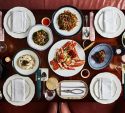Akhni fulab (lamb pilau)
Try a Bangladeshi version of what’s similarly known as a biryani. Lamb pilau, or akhni fulab, is a dish commonly reserved for special occasions such as Eid
-
Prep:1 hrs 10 mins
Cook:2 hrs 30 mins
- Easy
Nutrition per serving
-
kcal 619
-
fat 30g
-
saturates 13g
-
carbs 60g
-
sugars 0g
-
fibre 4g
-
protein 27g
-
salt 1.63g
Ingredients
- 1kg diced lamb (shoulder or leg)
- 2 large onions, sliced
- 5 garlic cloves, crushed
- 50g ginger, crushed or grated
- 4 bay leaves
- 4 cinnamon sticks
- 4 cardamom pods
- 3 heaped tsp mild curry powder
- 1½ heaped tsp ground coriander
- 1½ heaped tsp jeera powder (ground cumin)
- 1 tsp turmeric powder
- 4 tbsp ghee
- 700g basmati rice
- 3 tbsp vegetable oil
- 4 tbsp ghee , plus extra to serve (optional)
- 100g piece ginger, peeled and cut into thick matchsticks
- 2 large onions, sliced
- 4 bay leaves
- 4 cinnamon sticks
- 4 cardamom
- 5 cloves
- 20–25 whole black peppercorns
- 10 green chillies
Method
For the pilau, wash the rice under running cold water until the water runs clear. Soak in enough cold water to cover the rice and set aside.
Put the lamb in a pressure cooker (or standard pan if you are not using a pressure cooker). Add the onions, garlic, ginger, bay, cinnamon sticks, cardamom and 2 tsp salt. Mix thoroughly, cover the pressure cooker and secure the lid, and cook for 20-25 mins on low once the pressure has been reached (no need to add water). Or if you’re using a pan on the hob, cook the meat over a low heat for 1-1½ hrs, adding a splash of water before and during cooking, if needed. If you're using a pressure cooker, while the meat cooks, you can prepare the ingredients for the pilau. If you’re cooking it on the hob, wait until the meat is almost cooked before you start.
For the pilau, heat the vegetable oil in another large saucepan and add the 4 tbsp of ghee. Once the ghee has fully melted and the oil is hot, add the ginger and brown over a medium-high heat, stirring continuously for 10 mins. Stir in the onions and fry, uncovered, over a medium-high heat, stirring occasionally, until golden.
Remove the lid from the lamb and check the meat, allowing all the steam to escape before removing the lid if using a pressure cooker. You should see the fat bubbling around the edges of the pan to indicate the meat has cooked enough. Transfer to a large saucepan, if needed, put the pan on the hob and add the curry powder, coriander, jeera (cumin), turmeric and the 4 tbsp ghee.
Mix the spices and ghee, cover and allow the meat to cook for a further 15-20 mins, stirring now and then. In a pressure cooker, the liquid doesn’t evaporate and the spices will not roast well, so this needs to be done on the hob.
Once the onions for the pilau are golden brown, add the whole spices. Fry for a couple of mins before adding the soaked and drained rice. Add 1 tsp of salt, and fry over a medium heat for 8-10 mins, stirring to prevent the rice sticking. Add the whole green chillies.
Check the meat and test for tenderness, if you’re happy with it, add it to the fried rice; or turn off the rice and keep cooking the meat until tender, then heat up the rice and add the meat.
Fry the meat with the rice for several mins over a medium heat stirring frequently, then turn the heat up to high. Add some boiling water to the pan you cooked the meat in to extract any fat/flavour, then add this to the pilau. You should hear the water sizzle as it hits the pan, if you don’t hear this, you haven’t heated the pan up enough (this is important for a fluffy pilau).
Keeping the heat on high, top up the pilau with enough boiling water from your kettle and stir with a wooden spoon to ensure water reaches the bottom of the pan. Season the water to taste – it should taste salty. Add enough boiling water to just cover the rice and meat – you will need roughly 1 litre.
Cover the pan and keep boiling on high for 5 mins, then turn the heat down to medium and simmer for a further 5-7 mins. Uncover and check to see if all the water has been absorbed, if not, help disperse the water to the bottom of the pan by lifting the rice from the edges of the pan with a wooden spoon and stirring the water into the rice.
Finally, turn the heat down to low, cover the pilau with some foil and place the lid over the top. The foil traps the steam in and allows the moisture to drip back into the pilau as it cooks so it should not require any extra water. Leave to cook for a further 12-15 mins or until the rice is soft when pressed between your fingers. Dot some extra ghee over the top if you like, and cover with a lid to melt, then serve.





















